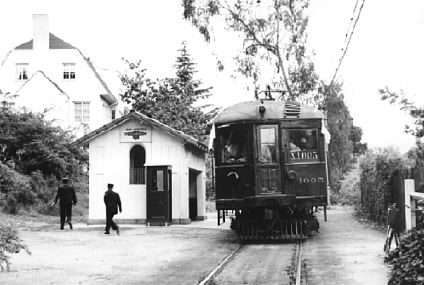HOLMAN COMBINE 1005
LAST SURVIVOR OF HER CLASS
Updated and corrected November 26, 2011
When the Oakland Antioch & Eastern opened for business in 1913, most of the local and secondary traffic was carried by the 1003 class motors, 13 composite combines purchased new for the operation. While not as attractive as the Northern Electric's Niles cars, they were rugged, powerful, and served both sections of the merged Sacramento Northern until the end of passenger service.
The first group were motors 1003-1006 built by Holman Car Company of San Francisco in 1912. The big cars were 58' long and 9' 10" wide. The Holman cars were visually similar to sister cars from Wason and Cincinnati, but each group varied slightly in height, length, width, baggage compartment length, and size of the end windows.

The Holman cars originally carried Brown roller pantographs over the baggage sections. These were soon replaced with Westinghouse 121-A pantographs which were mounted about 2/3 of the way back from the nose. Pantographs were used on joint SN-Key System trackage in Oakland. All powered cars carried front and rear trolley poles for pick-up on their own lines. On most SN track the motors ran at 1200 volts (later raised to 1500 volts), but they were switched to 600 volts for operation on the SN's 40th and Shafter trackage, over Key System lines, and on street trackage through Sacramento.
With the great merger of 1929, the management selected the South End combines to be the top power for the entire system. Their dual voltage capability made them the natural choice, since they could be used on 600 volt lines north of Sacramento. They were fitted with third rail shoe brackets (the shoes were applied and removed at Sacramento Union Station on through trains) and became a fixture at the head of trains system-wide. With the opening of the Oakland Bay Bridge to rail service in 1939, the big combines led trains all the way into San Francisco.

When the last vestiges of mainline passenger service ended in 1941, most of the fine interurban fleet was taken to the Mulberry Shops in Chico for scrapping. However, four South End combine cars, 1005, 1006, 1010, and 1015, plus Hall-Scott coach 1018, escaped for a while. These cars had been deeded to the California Bay Bridge Toll Authority in exchange for signalling and control equipment installed on cars operating across the Oakland Bay Bridge. The state sold the cars to scrap dealer Hyman-Michaels where they sat around awaiting an uncertain fate.
Following the Pearl Harbor attack, gasoline rationing and a boom in defense plants strained the Key System to capacity. The five motors were picked up at a bargain price, and after a quick shopping and repainting they were returned to service as Key System 495-499. The cars ran together in tripper service on the F-line and were unofficially known as "The City of Berkeley". This service ended in 1949 and four of the cars were scrapped in 1951.

Combine 1005 again escaped destruction. The car was sold to the Bay Area Electric Railroad Association for preservation for a mere $703.80. Restored to SN's green paint, 1005 ran on several excursions over the remaining electrified SN track in Oakland, as well as two trips on the Key System. The car was kept in the shops at 40th and Shafter along with several other pieces of BAERA-owned equipment. Following the Oakland line's closure in February 1957, the combine spent several years outside the Western Pacific roundhouse in Oakland.
During BAERA ownership, an extra trolley pole was added to the rear end of 1005's roof to aid with electrical pickup. In passenger days, the SN used sliding shoes on round wire over most of their non-third rail lines. By the 1950s, freight operation on the remaining electric lines was done almost exclusively with pantographs. This tended to flatten the wire and made electrical contact with 1005's shoes less reliable. The second pole was a stop-gap measure that allowed the car to be used run for excursions over SN lines.

While the car was enroute from Sacramento to Chico for a 1962 excursion in a freight train, the crew put 1005 in the middle of a long freight train. The slack action caused serious buckling of the center sills under the baggage section. After the Chico excursion, the car was never used for passenger runs again. In February 1964, 1005 was moved to the new BAERA museum at Rio Vista Junction.
In February 1999, BAERA announced that the Elliot R. Donnelley Family Trust had awarded the museum a $75,000 grant to restore 1005. The balance of the $180,000 needed to rebuild the historic interurban car was raised by subscription and smaller grants.

In January 2000, work began in earnest on 1005 with the arrival of restoration expert Glenn Guerra. After removal of the siding, considerable rot was found in the side sills. These were replaced with salvaged timbers from old buildings milled to fit. The bent steel sills were cut away and replaced with new metal. A complete restoration of the trucks was also done. As of April 2001, work began to replace rotted portions of the roof.

By mid-2011, restoration was substantially complete and the car was operated for testing purposes and the museum track. Problems with the resistors were uncovered in these test runs, and the car was returned to the shop for some final work in late 2011. With work nearing completion on Hall Scott coach 1020, and the museum planning eventual restoration of Bidwell, a complete Sacramento Northern train on original track will someday be a reality.


